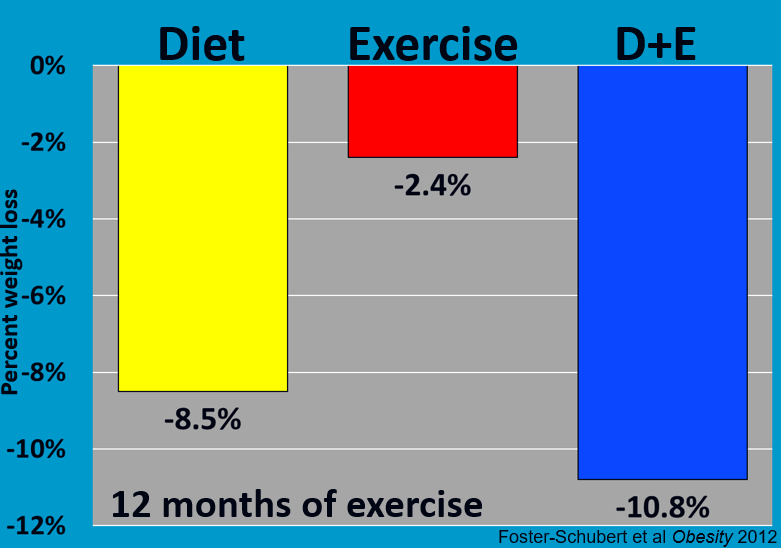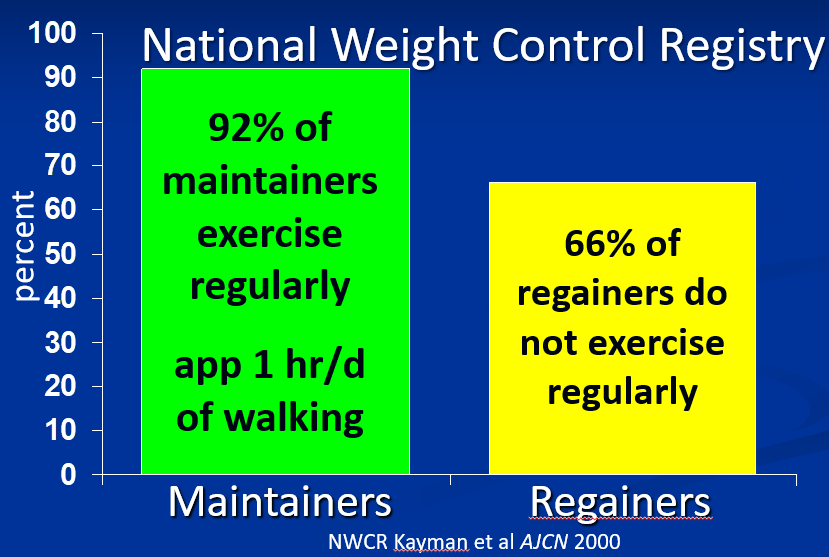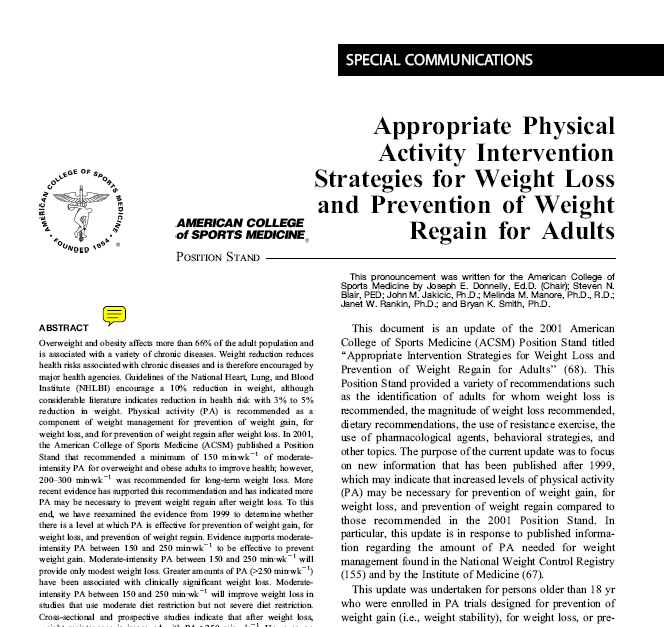
By Rich Weil, M.Ed., CDE
Transformation Weight Control
www.transformationweightcontrol.com
It’s well known that exercise does not cause very much weight loss. This graph tells the story best. If you have three groups of individuals, and they are assigned to one of three groups, 1) Diet-only, 2) Exercise-only, and 3) Diet and exercise, the diet and exercise group lost the most (-10.8%), but the exercise group lost the least (-2.4%). Muscle mass was measured with hydrostatic weighing (underwater weighing).

However, exercise is considered by many to be the single best predictor of keeping your weight off once you lose it. This graph is well cited to prove this point, and many other studies show similar results.

How much exercise you have to do to prevent regaining the weight you lost is not exactly clear. In the American College of Sports Medicine Position Stand (ACSM) on the subject from 2009 (see the image below), they recommend 200-300 minutes/week. That is: 1) five 40- to 60-minute bouts per week, or 2) seven 28- to 43-minute bouts per week.

I take exception to these guidelines because in the Position Stand, they state the following two problems with the research:
- “There are major flaws in the literature relative to research design”, and
- “There are no adequately powered randomized controlled studies of sufficient duration to judge the effectiveness of PA for preventing weight regain after weight loss.”
These are not very persuasive arguments for following the guidelines.
The fact is, you could burn one million calories a day with exercise, but if you consume one million and one calories on the same day, you’re not going to lose weight. The take-away is this: You must pay attention to calorie intake and not just exercise when trying to prevent regaining lost weight. You must burn more calories than you consume to lose weight.
As for how much exercise to do to prevent regaining lost weight? I recommend the following: 1) pay attention to your calorie intake, 2) follow the 2007 ACSM guidelines for exercise: healthy adults 18 to 65 years-old should do:
- Moderate-intensity aerobic exercise at least 30 minutes, 5 days per week, or
- Vigorous-intensity aerobic exercise 20 minutes or more, 3 days per week, and
- Resistance exercise: a minimum of 1 set of 8-10 exercises, 8-12 repetitions. (you can lose as much as 35% of your weight from muscle during weight loss, and with the new weight loss medications, which cause large and rapid weight loss, the muscle loss could be more than 42%. Muscle is important for dozens of reasons, but for the purposes of this blog post, you need to know that the association between muscle mass and metabolic rate is linear, that is, the more muscle you have, the higher your metabolic rate will be. And everyone who wants to prevent regaining lost weight wants their metabolic rate to be as high as possible.
- Important: The 30 minutes of moderate-intensity aerobic exercise mentioned in #1 can be accumulated in 10- to 15-minute bouts throughout the day.
But even with these guidelines, which will yield exceptional health results, no matter what, you’re going to have to experiment with the amount of exercise you do to keep your weight off. You’re simply not going to know how much exercise you need to prevent regain of lost weight until you get to the weight you want to be at and then see how much exercise it takes to stay there. And again, you must pay attention to your calorie intake. In the final analysis, it’s the combination of how many calories you burn vs how many calories you consume that will ultimately determine whether you prevent regaining lost weight or not. But one thing I am sure of, exercise is definitely part of the equation, you just need to determine how much. As I said, I recommend starting with the ACSM guidelines I mention above.
GOOD LUCK WITH YOUR TRAINING!
© 2024 Richard Weil All Rights Reserved